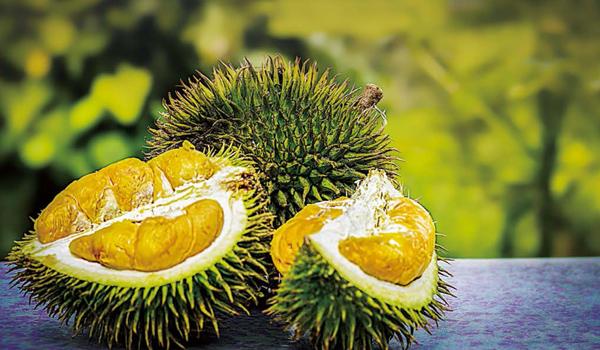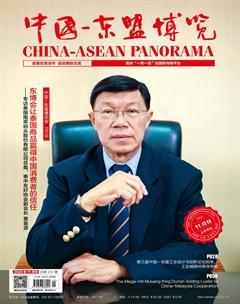猫山王榴莲走俏,让中马两国产业合作更有“味道”
黄利霞



近年来,随着中国消费者对榴莲品质追求的提升,被称为马来西亚榴莲界“爱马仕”的猫山王榴莲,逐渐在中国市场崭露头角。猫山王榴莲口感绵长顺滑、温润厚实,“吃一个正宗的马来西亚猫山王榴莲”,位列许多榴莲爱好者的愿望清单。
在2020年10月举行的中国—马来西亚(广西)线上榴莲节上,马来西亚猫山王受到了中国消费者“疯抢”,开幕首日不到一个小时,直播就售出了34.56万个榴莲,交易额达7000多万元人民币。而这一特色水果背后的巨大产业发展空间也受到了更多人的关注。
潜力无限的马来西亚榴莲市场
早在2011年,马来西亚就获准出口冷冻榴莲加工品、冷冻果泥及果肉到中国。2017年第14届中国—东盟博览会期间,马来西亚首次在广西南宁举办以榴莲为主题的农产品推介活动——马来西亚榴莲节,30多家马来西亚企业参与活动,共推广了200多种水果副产品。2018年8月,中马两国签署议定书,符合相关检验检疫要求的马来西亚冷冻整颗带壳榴莲获准进入中国市场。
由于猫山王榴莲要遵循“瓜熟蒂落”的自然规律,树上采摘或者开壳的“猫山王”是不宜食用的,所以在中国很难吃到新鲜的猫山王榴莲。在中国能吃到的只有冷冻猫山王榴莲及其制品,这一特性给猫山王榴莲初级加工品以及精加工产品,留下了较大的施展空间。
2019年6月,第一批马来西亚猫山王榴莲从吉隆坡通过空运抵达中国,并率先在上海和杭州两地上架。这是继2019年5月底,中国海关总署正式发文批准马来西亚整冻榴莲进入中国市场后,最早进入中国的一批猫山王榴莲,该批榴莲共5.54吨,价值约23.8万元。同年,中國的榴莲进口额同比增长47%,取代樱桃成为中国进口价值最高的水果。
马来西亚农业部相关负责人表示,冷冻带壳榴莲成功出口到中国,是大突破,将带动马来西亚榴莲产业的发展。马来西亚榴莲种植业不能只停留在初级产品出口层面,应发展下游产业,生产榴莲雪糕、榴莲薄饼、榴莲月饼、榴莲饼干、榴莲干等产品,创造出如榴莲辣椒酱、榴莲肉骨茶等新产品。“中马两国在农业方面有着广阔的合作前景,借助跨境电商平台带来的便利性,猫山王榴莲得以快速来到中国消费者面前。”这一负责人说。
2020年上半年,尽管中马双边贸易受到新冠肺炎疫情影响有所下滑,但中国市场对榴莲的需求不减反增。据中国海关数据显示,这一时期中国进口新鲜和冷冻榴莲共计16.2亿美元,同比增长73.5%,几乎达到2019年全年进口额18.2亿美元的水平。其中,中国进口冷冻马来西亚榴莲共计4037万美元,同比增长128.4%。
打造榴莲产业生态圈,深化中马经贸合作
中国已经连续11年保持马来西亚第一大贸易伙伴国地位,马来西亚也是中国的重要贸易伙伴和进口来源国。近年来,中国积极进口马来西亚棕榈油、燕窝、榴莲等产品,向马来西亚出口优质商品,使双边贸易切实惠及两国广大民众。与此同时,中马双向投资提质增效,中马“两国双园”、数字自贸区等大项目稳步推进。
作为中马两国经贸合作的重要推动者,中国(广西)自由贸易试验区钦州港片区(以下简称钦州港片区)一直致力于为中马双边经贸合作搭建桥梁。2020年以来,钦州港片区把握建设自贸试验区和国际陆海贸易新通道的新契机,加强与东盟国家的经贸合作,2020年1~9月,榴莲进口已超过8500吨;10月,钦州港片区举办首个以马来西亚猫山王榴莲为主题的东盟农产品专题推介活动,有力推动了广西与马来西亚在水果等农产品领域的交流合作。
广西中马钦州产业园区开发有限公司副董事长马汉坤看好马来西亚榴莲在中国市场的发展,他表示,马来西亚榴莲出口中国将在未来几年内呈倍数增长,随着原粒带壳榴莲获批出口中国,马来西亚榴莲产业在过去一年内飞速发展,整条产业链迅速成型。下一步,该公司将探讨在中马钦州产业园区建设马来西亚榴莲一条街,谋划布局马来西亚榴莲拍卖中心、物流中心、采购与供应商服务中心、电商服务中心以及生态展示中心全产业链的可能。
钦州港片区将继续以榴莲产业发展为重要抓手,优化通关服务,加大宣传推广力度,完善供应链环节,打造一个良好的榴莲产业生态圈,让中国广阔的市场和马来西亚特色产品无缝对接,撬动中马两国在更广领域的经贸合作。
In recent years, with Chinese consumers increasing pursuit of the durian quality, the Musang King durian, known as the “Hermès” in durian in Malaysia, has gradually distinguished itself in the Chinese market. Musang King durian has a tender, moist and thick flavor which will linger on the mouth for a long time, thus having a taste of the authentic Musang King durian from Malaysia is a dream of many durian fans.
During the China-Malaysia (Guangxi) Online Durian Festival launched in October 2020, Malaysian Musang King durians were snapped up by Chinese customers. In less than one hour after the launch ceremony, over 345,600 durians were sold through the live stream, with a transaction volume of more than RMB 70 million yuan. In the meantime, the broad outlook of its industrial development got more attention.
Malaysian durian market with dynamic potential
As early as 2011, Malaysia was allowed to export processed frozen durian products, frozen durian puree and durian pulp to China. At the time of the 14th China-ASEAN Expo in 2017, Malaysias first durian-themed agricultural product promotion, Malaysia Durian Festival was held in Nanning, Guangxi. More than 30 Malaysian enterprises participated in the event and over 200 fruit byproducts got promoted. In August 2018, China and Malaysia signed a protocol, which allowed Malaysian unshelled frozen durians that meet relevant inspection and quarantine requirements to enter the Chinese market.
The Musang King durian is edible only if it falls from the stalk with full ripeness rather than being picked or shelled, so it is difficult to have a fresh Musang King durian in China. Only frozen Musang King durian or processed products are available in China, which left a great development space for the primary processed and refined products of Musang King durian.
In June 2019, the first batch of Malaysian Musang King durian arrived in China by air from Kuala Lumpur, and was the first to be put on shelves in Shanghai and Hangzhou. With 5.54 tons in weighs and RMB 238,000 yuan in value, it was the first time that Musang King durian was imported into China since the General Administration of Customs of China (GACC) officially issued a document to approve Malaysian frozen durian to enter the Chinese market at the end of May, 2019. In the same year, Chinas durian imports increased by 47% year-on-year, replacing cherry as Chinas most valuable fruit by import value.
A person from Malaysias Ministry of Agriculture indicated that the successful export of frozen in-shell durian to China is a breakthrough and will drive the development of the Malaysian durian industry. The durian farming industry in Malaysia should not just stop at exporting primary durian products. It should develop downstream industries to produce durian ice cream, durian crepes, durian moon cakes, durian biscuits, dried durian and other products, and create new products such as durian chili sauce and durian bak kut teh. He also said: “There are broad prospects for cooperation between China and Malaysia in agriculture. With the convenience of cross-border E-commerce platforms, Musang King durian can quickly be deliveried to Chinese consumers.”
In the first half of 2020, despite the outbreak of the COVID-19, the demand for durian in the Chinese market has increased rather than decreased. According to the data from China Customs, Chinas imports of fresh and frozen durian totaled US$ 1.62 billion during this period, up 73.5% on a year-on-year basis and nearly reaching the US$ 1.82 billion in imports for the whole of 2019. Among them, China imported frozen Malaysian durian worthy of US$ 40.37 million, registering a year-on-year increase of 128.4%.
Build a durian industrial ecosystem to deepen China-Malaysia economic and trade cooperation
China has been Malaysias largest trading partner for 11 consecutive years and Malaysia is Chinas seventh-largest trading partner and source of imports. In the past few years, China has actively imported Malaysian palm oil, birds nest, durian and other products, and also exported high-quality products to Malaysia, making bilateral trade more tangible and beneficial to the general public of the two countries. At the same time, two-way investment between China and Malaysia is improving in quality and efficiency, and major projects such as “Two Countries, Twin Parks” and Digital Free Trade Zone are making steady progress.
As an important promoter of economic and trade cooperation between China and Malaysia, Qinzhou Port Area of China (Guangxi) Pilot Free Trade Zone (hereinafter referred to as Qinzhou Port Area) has been committed to serving as a bridge in China-Malaysia bilateral economic and trade cooperation. In 2020, Qinzhou Port Area has seized the new opportunity of building a pilot free trade zone and a new international land-sea trade corridor, and strengthened the economic and trade cooperation with ASEAN countries. From January to September 2020, durian imports from Malaysia have exceeded 8,500 tons. In October, Qinzhou Port Area held the first special promotion activity for ASEAN agricultural products with the theme of Malaysian Musang King durian, which strongly deepened the exchange and cooperation between Guangxi and Malaysia in agricultural products including fruits.
The Vice Chairman of China-Malaysia Qinzhou Industrial Park (Guangxi) Development Co. Ltd. (CMQD) Dato Beh Hang Kong is bullish on the development of Malaysian durian in the Chinese market. He stated that the export of Malaysias durian to China will see multiple growths in the next few years, and with the export of unshelled durian to China being approved, the Malaysian durian industry has developed rapidly in the past year, and the entire industrial chain has taken shape rapidly. Next, the company will explore the construction of a Malaysian durian street in the China-Malaysian Qinzhou Industrial Park, planning the layout of the auction center, logistics center, procurement and supplier service center, E-commerce service center and ecological exhibition center for Malaysian durian.
The Qinzhou Port Area will continue to take the development of the durian industry as an important starting point, optimizie customs clearance services, increase publicity and promotion, improve the supply chain, and create a good durian industry ecosystem, to ensure seamless integration between the vast Chinese market and products with Malaysian characteristics, and to leverage the economic and trade cooperation between China and Malaysia in a wider range of areas.

